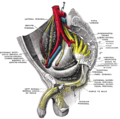| Obturator nerve | |
|---|---|
 Structures surrounding right hip-joint. (Obturator nerve labeled at upper right.) | |
 Nerves of the right lower extremity. Front view. | |
| Details | |
| From | Lumbar plexus L2-L4 |
| To | Posterior branch of obturator nerve, anterior branch of obturator nerve |
| Innervates | Medial compartment of thigh |
| Identifiers | |
| Latin | nervus obturatorius |
| MeSH | D009776 |
| TA98 | A14.2.07.012 |
| TA2 | 6532 |
| FMA | 16487 |
| Anatomical terms of neuroanatomy | |
The obturator nerve in human anatomy arises from the ventral divisions of the second, third, and fourth lumbar nerves in the lumbar plexus; the branch from the third is the largest, while that from the second is often very small.



















